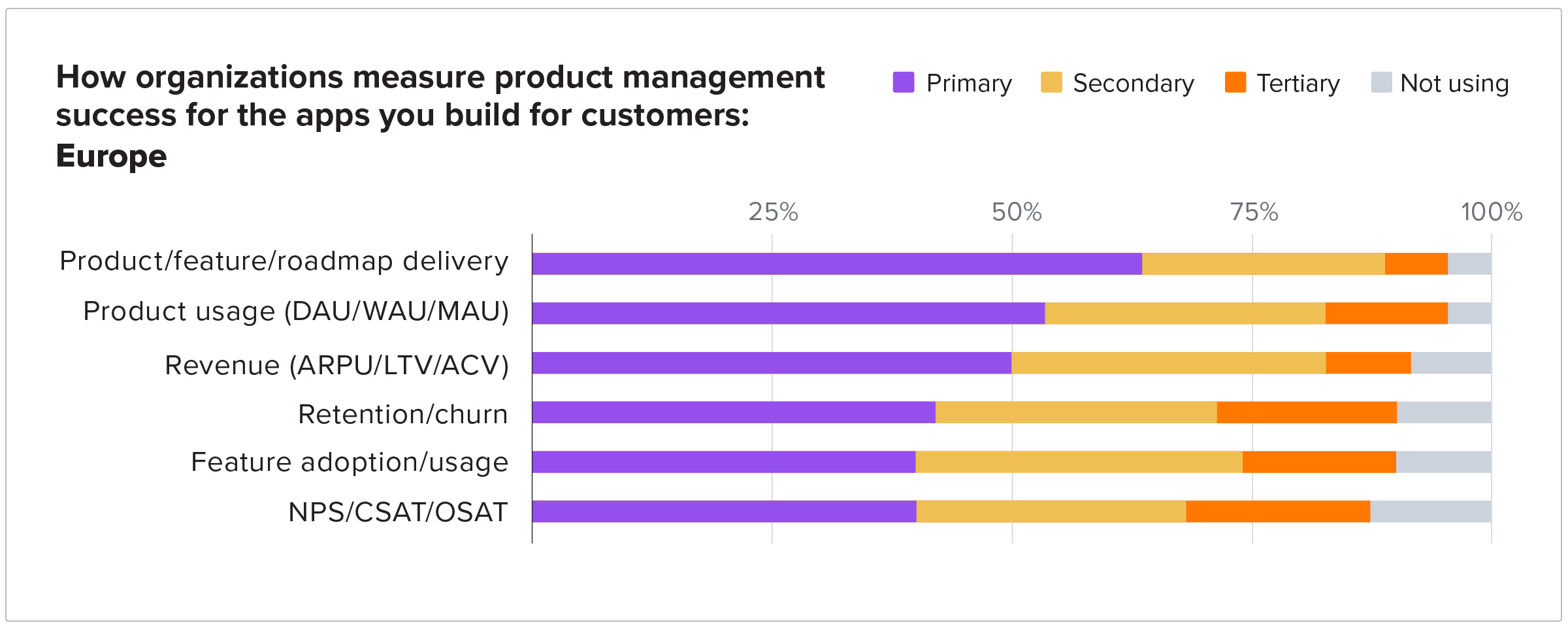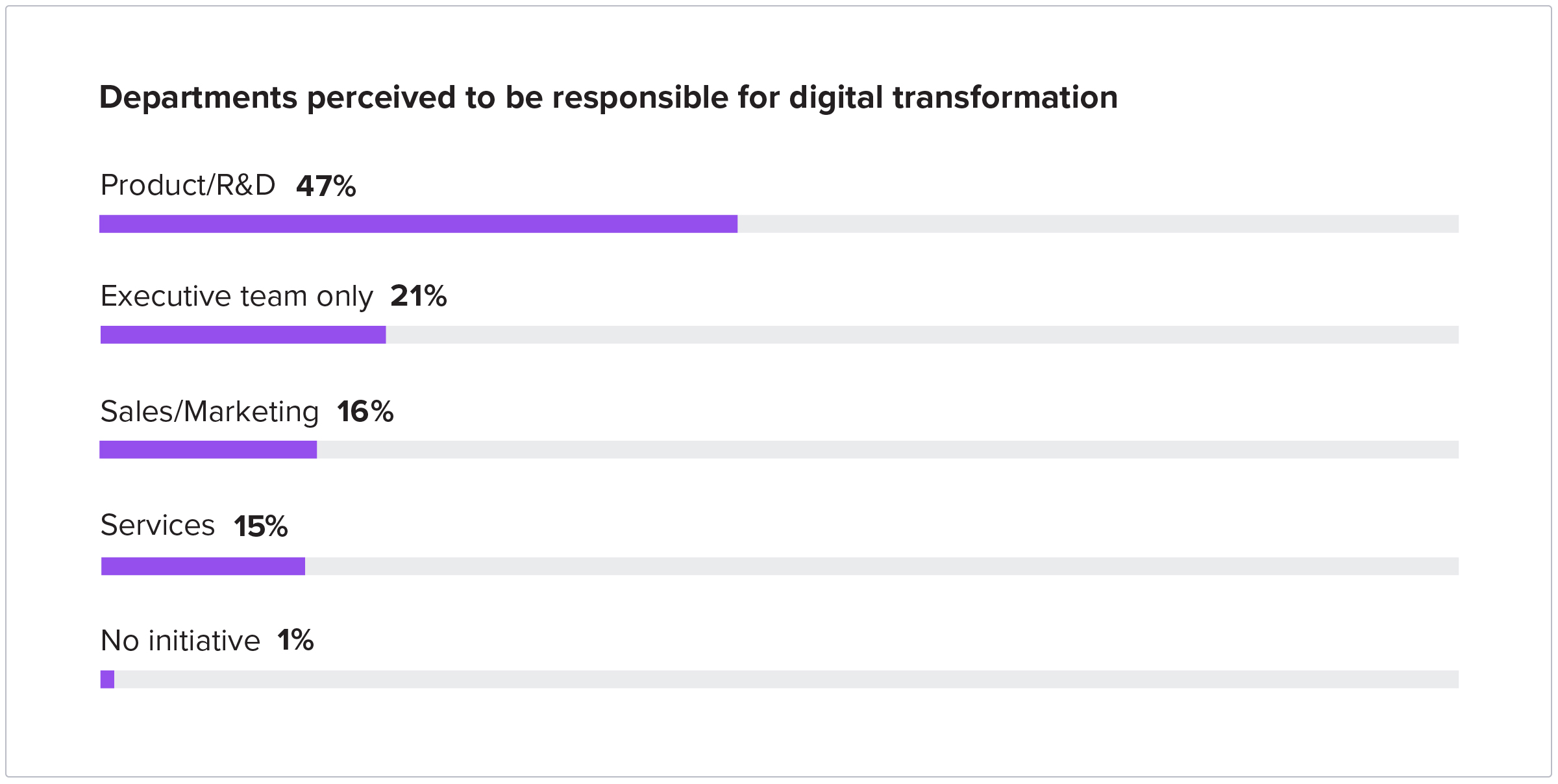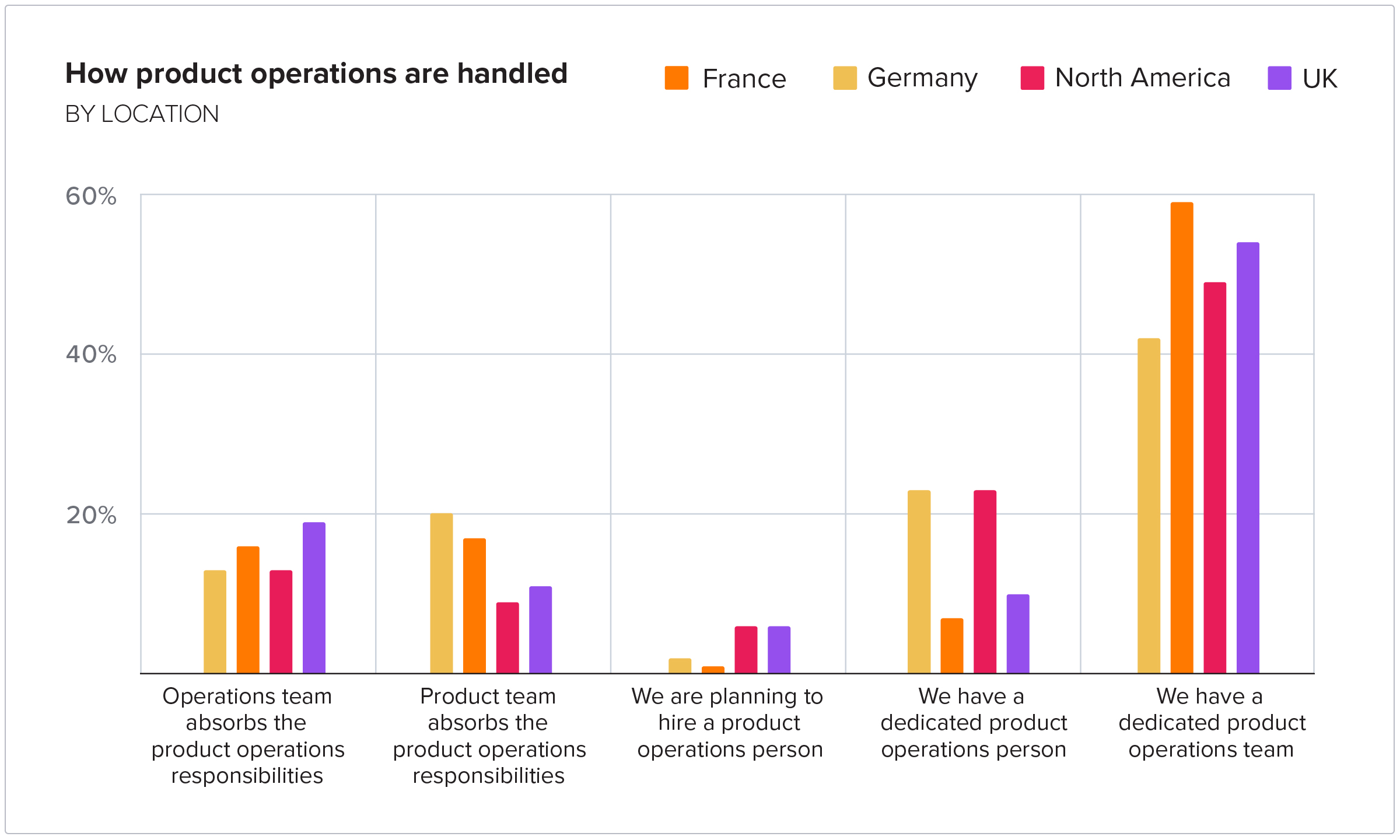
Table of Contents
- The big picture
- Who we surveyed
- Finding 1: Becoming more data-driven
- Finding 2: Product leaders are visionary multi-taskers
- Finding 3: Connecting product strategy to revenue
- Finding 4: Responsibility for digital transformation
- Finding 5: Increased pressures impacted job satisfaction
- Finding 6: Collaboration offers motivation and support
- Recommendations
In a rush?
Download the PDF for later
Each year, Pendo and Product Collective set out to take the pulse of the global product industry and examine the evolution of the product manager (PM) role. As the world underwent radical shifts in the past year, it put a spotlight on the strength and integrity of Europe’s digital economy. Digital transformation initiatives are accelerating, innovation is forging ahead with no interruptions, and product teams are crucial to ensuring these efforts are successful.
In our 2021 European State of Product Leadership report, now in its third year, we explore the product leader’s place in this fast-moving era of digital transformation. The report is based on a survey of product professionals in the United Kingdom, France, and Germany, and reveals six key findings about how they’re navigating this historic moment. It also begets the question: How can companies best support the product leaders who are steering Europe into the future?
Which companies are the most data-driven?
In Europe, traditional enterprises use quantitative data to make roadmap decisions more than any other type of company, presenting an opportunity for others to follow suit.
Breaking down European product leaders’ responsibilities
European product leaders are multi-taskers, and more likely to manage more than one product compared to their global counterparts.
Product teams are spearheading digital transformation
Product and R&D teams are leading the charge for digital transformation in Europe, regardless of which function drives an organisation.
The big picture
Europe is well-positioned to lead the world through our new, fast-moving era of digital transformation. Despite the pandemic, 2020 was a record year for investments in European startups and innovation is forging ahead with no interruptions. This trend speaks to the strength and integrity of Europe’s digital economy.
Consider Hopin, for instance, which raised $400M at a $5.65B valuation to build the future of event technology. European companies like Hopin have a unique competitive advantage in creating high-impact cultures, products with cutting-edge user experiences, and values that attract top talent globally. With these new global innovation movements, product leaders need to reach new frontiers in their impact and capabilities, fast. The global economy is navigating “a great digital transformation race,” in the words of KPMG—and the stakes are higher than ever.
Every company is crossing a mission-critical chasm between “now” and “future-now” due to accelerating digital adoption timelines. Whether we succeed or fail is entirely up to our individual and collective judgment calls as strategists, managers, and builders. You can read more about Pendo’s insights into digital transformation from a global perspective here.
In our 2021 European State of Product Leadership survey, now in its third year, we explore the themes most important to product leaders—and the decisions they’re making during this historic moment. How can companies best support the product leaders that are steering Europe into the future?
Who we surveyed
In December 2020, we surveyed 300+ product managers and executives working largely for B2B software companies and traditional enterprises in France, Germany, and the United Kingdom. Here is a summary breakdown of the respondent profile:


Finding 1: Becoming more data-driven
There’s an opportunity for product leaders to become more data-driven.
Even though 63% of product leaders across France, Germany, and the United Kingdom report being data-driven, only 40% say that they make product roadmap decisions based on quantitative sources. This finding suggests that there is room for new tools, educational resources, and training to empower a stronger level of data-driven decision making. Are teams equipped to make their best judgment calls, on the fly?

While qualitative instincts are valuable for digging deeper into trends and identifying new opportunities, quantitative data is essential for getting teams and departments around a shared foundation for measurement, driving adoption, and growth—metrics that are critical to a business’s health.
Digging deeper into this trend, who’s most comfortable working with product data, and who isn’t?

Our survey found that product leaders with a creative academic background (fine arts, graphics, design) are most likely to rely on quantitative data (75%). Product leaders with technical and engineering backgrounds were least likely to be using quantitative data (35%)—it could be the case that engineering teams are most likely to need support turning their data into human stories.

Traditional enterprises were the most likely to be data-driven in Europe, suggesting that there is opportunity for growth for SaaS companies and other types of organisations to become more quantitative in their thinking.

Finding 2: Product leaders are visionary multi-taskers
European product leaders ranked product vision/strategy and roadmap/prioritisation as their key areas of focus in 2021. In the previous year’s study, for comparison, these objectives were further down the list. This finding suggests that product leaders in Europe are taking on more ambitious responsibilities, perhaps due to the heightened pressures that come with digital transformation.
In addition to operating with a high degree of focus, European product leaders also demonstrate exceptional multitasking capabilities—33% manage more than one product, according to this year’s survey. For comparison, 29% of global product leaders are responsible for more than one product.


In the U.K. the number of product leaders responsible for more than one product jumps to 43%. This trend correlates with U.K. product leaders being more responsible for increasing customer adoption metrics than their counterparts in France or Germany.

Product management is an inherently multidimensional field that requires both visionary thinking and multitasking. Product leaders in the U.K., followed by Germany and then France, demonstrate strong capabilities in this area.
Finding 3: Connecting product strategy to revenue
European product leaders are powerful connectors between product vision/strategy and core business outcomes—such as revenue.
European product leaders (50%) ranked revenue among the top three primary success metrics they are monitoring, which suggests that they are taking a customer-centric approach to monetisation. In the global survey, 45% listed revenue as a primary success metric.

This trend correlates with product usage being more important to European product leaders than to product leaders globally. For customer-facing applications, 53% of respondents in Europe listed product usage metrics as a primary measure of success, compared to 41% of respondents globally.
These subtle differences in mindset suggest that European leaders may have a stronger alignment between customer experience and financial performance.

Despite the strengths of product leaders as visionary multitaskers with a revenue focus, there’s still room to improve. The 2021 report found that European product leaders felt less responsible or accountable for product vision/strategy (39%) than their global peers (46%).
Finding 4: Responsibility for digital transformation
Product is at the head of the table for digital transformation—but they may not see themselves in this light.
Likely due to their visionary and multidimensional thinking capabilities, product leaders are at the forefront of digital transformation in Europe. Out of all the European product leaders we surveyed, 47% perceive product and R&D teams to be responsible for digital transformation.

This trend holds true within companies that are marketing/sales and executive led, meaning that product teams have a high degree of influence over their companies’ future. This trend also holds true across companies large and small—product leadership is invaluable.


Given these perceptions, only 45% of respondents report feeling responsible or accountable for digital transformation at their companies. Although they are considered to be leaders in this space, European product pros haven’t fully actualised their responsibility for digital transformation.
Building on this trend, product leaders are well-positioned to step up to this leadership calling due to the growing maturity of their operations. Product teams are becoming increasingly well resourced and supported, with 44% of survey respondents indicating that they have access to a product operations team. In comparison, last year, only 26% of respondents shared that they are working with a product operations team.

Germany, known for its high integrity product design and manufacturing methods, is in the lead with respect to the number of survey respondents having access to a dedicated product operations team.
Finding 5: Increased pressures impacted job satisfaction
Likely due to increased pressures, job satisfaction took a hit over this last year.
Product leaders are held to high regard and esteem. But their job satisfaction is on the decline, according to our 2021 survey. It’s understandable—the pace of digital transformation means that leaders are under pressure to perform to superhuman levels.
One of the questions we asked product leaders in this year’s survey is how likely they would be to recommend their career paths to a friend. Out of a total net promoter score (NPS) range from -100 to 100, the average score was -1, compared to an overall global score of 9.
Job satisfaction was highest, but still quite low, at traditional enterprises with digital offerings (NPS = 6), with SaaS companies following in a close second (NPS = 5). Globally, the average NPS score at traditional enterprises was 8, and the NPS score for SaaS companies was 17.

These findings suggest that product leaders may be under extreme pressure–especially due the personal responsibilities that they are navigating during the pandemic and human health crisis. One point of validation is that respondents that have access to a dedicated product operations team reported higher NPS scores (7).

When we examine by job level, independent contributors reported the lowest NPS scores (-26), potentially due to the pressures and responsibilities that they are shouldering. Meanwhile, employees at smaller companies were least happy, reporting an average NPS score of -24. NPS scores were highest (10) at companies in the $51M-$100M range—the equivalent of a Series C stage company.
At the country level, product managers in Germany were the happiest, albeit with an NPS of 4. In comparison, North American product managers reported an average NPS score of 19.


Finding 6: Collaboration offers motivation and support
Collaboration helps ofer motivation and support.
Product leaders may be spearheading digital transformation, but they certainly aren’t alone. Our survey found that product teams are in close alignment engineering teams, followed by design, marketing, and sales—and that independent contributors, managers, and executives are equally likely to be working cross-functionally with diferent teams and departments.
Product teams are leading a powerful range of unique collaborations—a skill that is invaluable, in both the short and long term, for digital transformation to be successful.

Perhaps recognising and self-actualising this leadership and teamwork will help raise morale. Data can help product leaders better recognise the full value and extent of their contributions—especially when enhancing alignment with teammates in other departments.
Recommendations
Recommendation 1: Optimise the use of data.
Especially as European product leaders take on more responsibilities, they need faster and more agile ways to make decisions. The survey found that product leaders with creative backgrounds were both happier and more likely to be using data. Is this a correlation or causation—that being data-driven helps product leaders find meaning and joy at work?
Digital transformation is a big vision, but it’s the tiny moving parts of everyday operations that lead up to overarching goals.
The right data can help instill confidence in the direction that teams are taking.
Recommendation 2: Increase positive interactions between teams.
Humans are hardwired to find meaning and purpose at work. With job satisfaction having taken a hit during the pandemic, it’s hard for individuals to achieve the groundbreaking results that they need from digital transformation.
Collaborations are already happening. So why not take them to the next level through gamification, educational events, and other supportive endeavors?
These collaborations can help bring joy to an otherwise high-pressure digital transformation journey. Higher morale will lead to more cross-functional company direction, stronger product leadership, greater productivity, and higher resilience to change.
Recommendation 3: Ensure that product leaders have a c-suite track.
With product leaders being at the forefront of digital transformation, these individuals are well-positioned to become the CEOs of tomorrow. The first step is to ensure that every product leader has c-suite representation—after all, product leaders are multifaceted thinkers with crossfunctional customer insight.
Giving product leaders a seat at the table gives creativity a seat at the table, too. That’s the skill that the world needs right now. Product leadership is mission-critical to ensure alignment between customers, stakeholders, and revenue.
